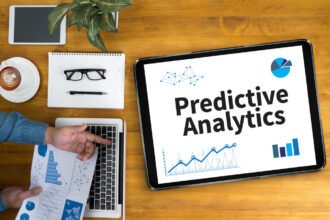Analytics is becoming more important than ever in the world of business. Over 70% of global businesses use some form of analytics. This figure will rise as globalization, supply chain challenges and other factors increase competitiveness.
This is an important year for enterprises keeping in view that most global industries are recovering from the pandemic horror, and the era of web 3.0 is at the doorstep. For both reasons, the role of CIOs has to embrace automation and analytical thinking in strategizing the organization’s initiatives. Until now, they were proactively involved to maximize IT efficiencies and accelerate cost savings in general.
However, the rapid technology change, the increasing demand for user-centric processes and the adoption of blockchain & IoT have all positioned business analytics (BA) as an integral component in an enterprise CoE. They are using analytics to help drive business growth. And since no one except CIOs has the technical nerve of a business; they are seizing the opportunity to increase value to the organization while positioning themselves as thought leaders.
While we are at it, Gartner’s 2022 report on business composability further pushes the need for analytics. It suggests the immediate need for decision-makers including CIOs to embrace automation to absorb the pressures of the rapidly changing business landscape.
Continuous Building of BA practice in your organization
Even though business analytics operates across organizational verticals and all levels of the hierarchy, a CIO owns the responsibility to ensure the building of the practice. It requires a deep-rooted understanding of the organizational workflows and the scope of analytics in making significant improvements. Therefore, building BA is a continuous practice and often involves partners to kick-start.
One such education institution called Adaptive US collaborates with multiple organizations with a focus on building/improving their BA practice. Such platforms provide full-stack training solutions for IIBA certifications & several training programs for professionals of different work experience groups. Various educational groups deliver sessions in different formats such as self-learning, guided learning, live & recorded sessions, exam prep sessions, office hours and others to suit the learning needs of the various kinds of learners.
CIOs, in collaboration with such groups, can categorize their practice building into 3 focus areas:
- Team Upskilling: Train business analysts on planning, gap analysis, scoping & blueprinting, cost-benefit calculation of new initiatives, solution architecture, modelling, elicitation, requirement management, performance management, and other improvement initiatives.
- Process Upgrade: Ensure following industry standards and benchmarking the process against the Business Analysis Body of Knowledge (BABOK) and modernize them.
- Tools Updating: A business analyst is as good as his/her tools. Having effective tools is vital to the organization’s success. Having cost-effective and high-quality business analytics tools such as Atlassian, MS Visio, Business Process Modeller, Balsamiq, and similar BA tools is essential for org initiative improvement.
Not to miss, Cloud analytics are increasingly dominating their on-premise predecessors. It is growing at a CAGR of 23.0% and shall touch USD 65.4 bn by 2025.
Executive Portfolio Management
Unlike previously when only corporates would consider portfolio management as an important arm of C-level decision making, scenes are different today. Given the on-demand accessibility of data, start-ups and SMEs want their CIOs to manage resource investments through application portfolios, infrastructure portfolios, and project portfolios.
Since there’s vast information at disposal, business analysis has a crucial role for CIOs. Here, the dashboard could include project health elements such as cost, schedule, scope, ROIs, feedback, value to the partner, evaluation of meaningful outcomes, and management hierarchy to name a few. Not to miss, a low-level (detailed) view of such a dashboard would include a problem statement, business case, status, budget, delegation, etc.
The answers captured above further enable a CIO to create a top-level view and evaluate how optimal is the spending, how progressive is the pipeline and ultimately how on track are the committed deliverables.
Extract Value From Customer
Predictive analytics have an unquestionable influence on drawing patterns around consumer behavior and their likelihood to either re-subscribe or discontinue the service. Based on the engagement with the product, the customer experience team, a key part of the CIO’s team has to score customers on these metrics and position them in the growth funnel, also known as the pirate funnel.
This sales/marketing funnel can consume insights from BA to predict the probability of upselling. Subsequently, the outcome of the tool/funnel would prompt the ‘sales’ to offer incentives or other rewards against an upsell or referral to the potential customers. This analytical ability to predict customer churn can assist insetting appropriate goals but also strengthening their financial planning area as discussed previously.
Financial Management
Financial planning is a critical area and involves all stakeholders including CIOs. For most organizations, it sets the narrative for project forecasting, recruiting, scaling, and others. CIOs, along with everyone on the leadership board use finance models to anticipate any hurdles.
For CIOs, financial planning coupled with business forecasting through analysts is a primary role. So if the overall spending trails the expected forecast, it’s a good indicator and an opportunity to discover newer avenues that could work for the organization. At the same time, if the spending exceeds the expected limit, CIOs have to identify weak links and rewrite the quarterly plan.
Financial visualization in key areas can fuel analytical decision-making. These include budgeting, forecasting, actuals & accruals, variance & absolute variance, spending economics, vendors, contracts, and more.
Conclusion
Organizations waking up to the importance of analytics at C-level decision-making need no detailing. However, the market trends in the post-pandemic era ask for rapid adoption and CIOs are at the helm of that transformation. So far, we discussed the confluence of business analytics across verticals and how that changes the role of CIOs. From the discussion, it is inevitably clear that this association will further strengthen in the web 3.0 era. Organizations that have captured the hint will have a lasting stint in the competition.
If you are building a career in business analytics, you are a step closer to building a profession as a future CIO.







